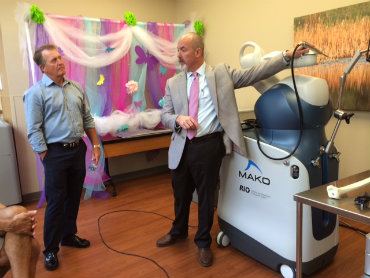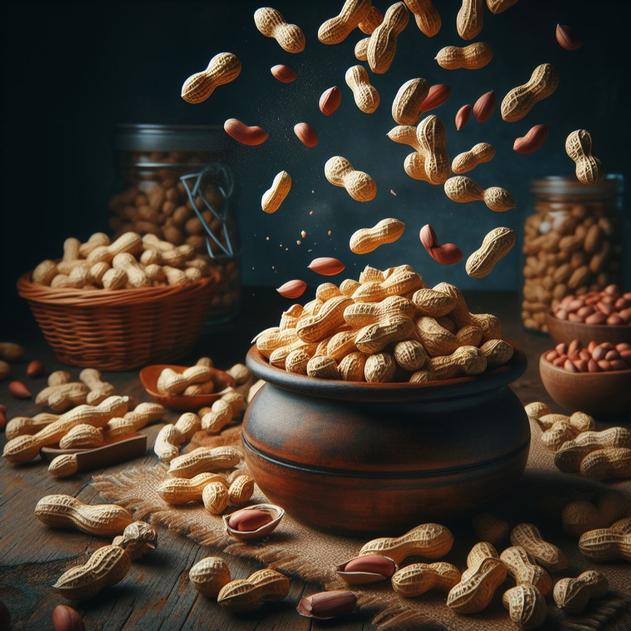- Sections :
- Crime & Public Safety
- Restaurants & Food
- Sports
- More
Memorial Hermann introduces MAKO robotic for partial knee & hip replacements

THE WOODLANDS, Texas - Memorial Hermann The Woodlands is expanding its surgical procedures to include both total hip and partial knee resurfacing using MAKOplasty®, an innovative procedure using the surgeon-operated RIO® Robotic Arm Interactive Orthopedic System which provides consistently reproducible precision.
Owned by Stryker Orthopaedics, the MAKO technology has revolutionized how full hip and partial knee surgeries are performed, requiring a minimum amount of time in surgery, a less invasive procedure, and a faster recuperation period.
Orthopedic surgeon Dr. Adam Freedhand, a professor for UTHealth, The University of Texas, and on staff with Memorial Hermann, demonstrated the MAKO Thursday in the atrium of the hospital. Dr. Freehand performs the partial knee procedure on an outpatient basis.
“This equipment is a game changer for accuracy and precision,” said Dr. Freedhand.
In programming the robotic system, its accuracy eliminates the systematic errors; its precision prevents random errors.
The surgery for a partial knee procedure is typically thirty minutes,” said Dr. Freedhand. “There’s no physical therapy required, and as long as the patient can demonstrate the ability to walk with a minimum amount of pain, they can be dismissed. A total hip replacement takes a little longer, 45 minutes to an hour. Within two weeks patients feel better than before the surgery.”
As Dr. Freedhand explained it, the majority of the prep work takes place prior to the surgery, starting with a CT scan which is programmed into the robotic to make a 3D model. This enables the surgeon to plan the surgery in a virtual world...the location and extent of the required resurfacing, the orientation of the parts on the bone, and how to adjust the medial collateral ligament (MCL) that balances the Femur (thigh bone) and Tibia (shin bone).
“This expedites the surgical procedure greatly reducing the amount of time the patient is under anaesthesia. It’s also less invasive, so there’s less pain,” said Freedhand. “Prior to the MAKO we couldn’t do any of the prep work until we went in and took a look at the damage to the joint.”
When the surgery does commence, MAKO is the tool that selectively resurfaces the area based on the preprogrammed data from the CT scan, with accuracy to within one quarter of a millimeter. Trackers are placed on the patient’s bone to register the physical subject to the 3D image in the computer. This prevents the resurfacing tool from moving beyond the programmed parameters, controlling the depth and orientation of the resurfacing.
Because the MAKO is a passive robot, it doesn’t operate on its own. It requires a controller, so the surgery is performed through the teamwork of the surgeon and a MAKO certified technician, who work in tandem on the procedure.
“It takes teamwork. The technician operates the workstation module, the surgeon operates the robotic arm,” said Brad Cowan, a MAKO certified technician.
The surgeon operates the robotic arm much like a stylus, while viewing the procedure on a monitor. The robot does the ‘hands-on’ work.
“Working together using the MAKO, we can achieve exactly the precise orientation, which extends the life of the procedure. This also enables us to custom fit with off-the-shelf components,” said Dr. Freedhand. “The best analogy is that the MAKO is a GPS, compared with someone using a roadmap for navigation.”
On hand for the demonstration was PGA Tour of Champions professional golfer, Fred Funk, in town for the Insperity Invitational Tournament. Funk underwent knee replacement surgery on his right knee in 2009, both the inside and outside of the knee. Stryker Orthopaedics’ GetAroundKnee™ procedure got Funk back in the game, using a round instead of oval, knee replacement, designed to replace the knee's naturally circular motion. (This was prior to Stryker’s acquisition of the MAKO RIO® system.) Later that year Funk became the oldest qualifier at age 53, for the U.S. Open. Two months later Funk won his second major championship on the Champions Tour at the 2009 U.S. Senior Open. With a third senior major victory at the 2010 Jeld-Wen Tradition, he became the first player to win a PGA Tour-sanctioned event after knee-replacement surgery.
When someone in the crowd stated that the knee replacement surgery appeared to have improved his game, Funk replied, “Actually, it help me get my game back.”
Funk is no stranger to Houston. In 1992 he won the Houston Shell Open with an impressive 16- under par score, and is an annual favorite at the Insperity Tournament in The Woodlands. Among his other accolades, since turning 50 in 2006, Funk has been eligible for the Champions Tour events and debuted in the U.S. Senior Open. He is featured in the top 50 of the Official World Golf Ranking. On the first flight, Funk will be playing with Tom Kite and Lee Janzen in this week’s Insperity Tournament.
Dr. Freedhand estimates that Funk’s surgery, with the use of better quality plastics and metal components used by Stryker, has a tenure of 15 to 20 years, enabling him to play golf at least until age 70, at which time, the knee can undergo another resurfacing using the MAKO, or whatever the next generation of technology will be at that time.
Hal Sutton, another pro golfer in town for the Insperity Invitational, underwent a Stryker right hip replacement in 2012, and a left hip in 2013. Stryker’s less invasive surgical methods are keeping pro athletes at the top of their game.
Although the introduction of the MAKO RIO® is relatively new, Stryker Orthopaedics was has been performing partial knee replacements since 2006, and hip replacements since 2010. MAKO Surgical was founded in 2004, and introduced the first MAKOplasty Partial Knee Replacement Procedure in 2006. To date, approximately 40,000 surgeries have been performed using the MAKO robotic. Stryker Orthopaedics owns the patents and the MAKO robotics, gaining considerable competitive advantage for the next evolution in joint resurfacing and replacement.
Dr. Freedhand said the learning curve on the MAKO robotic is minimal.
“The surgeons already know how to do knee and hip replacements, it’s just learning how to digitally perform the surgeries,” said Freedhand. “The technology is making us better surgeons. It’s like having a really good caddy.”
Some on hand to view the MAKO demonstration stated that they were experiencing discomfort, but were considering joint resurfacing or replacement until later in life.
“Why would you spend the next decade or two in pain when you can have the procedure now and enjoy the next twenty years pain free,” said Memorial Hermann’s Senior Communications Representative, Evan Koch.
“The older you are, the longer the recuperation period because you’re less active. The sooner the better,” added Linda Nelson, Director of Business Unit Marketing at Memorial Hermann The Woodlands.
For insurance purposes, the insurance code for the MAKO robotic procedure is the same as the conventional partial knee or hip replacement surgeries.
As for Fred Funk, he states that he’ll continue to play golf as long as he can qualify for the PGA Tour. He’ll be breaking ground on a course he’s designing in Windsor, Colorado, just north of Denver.
“It will be an upscale public course with $200 green fees, no homes,” said Funk. “I joke that it always rains on me, so the course will be named appropriately, Raindance. It will be open late summer or early fall of 2017.”
For more information about the MAKO RIO® Robotic Arm Interactive Orthopedic System call Memorial Hermann the Woodlands at 713-897-2300. #MakoRio #Kneejerk #Raindance #Fore #FunksPunks #StrykerMako



















